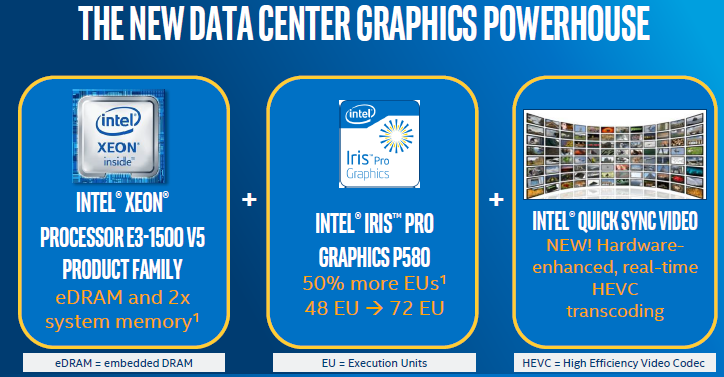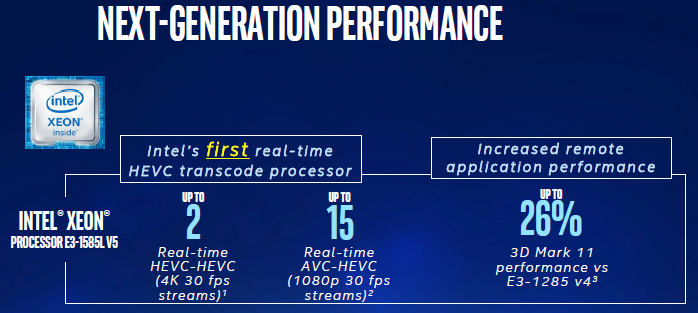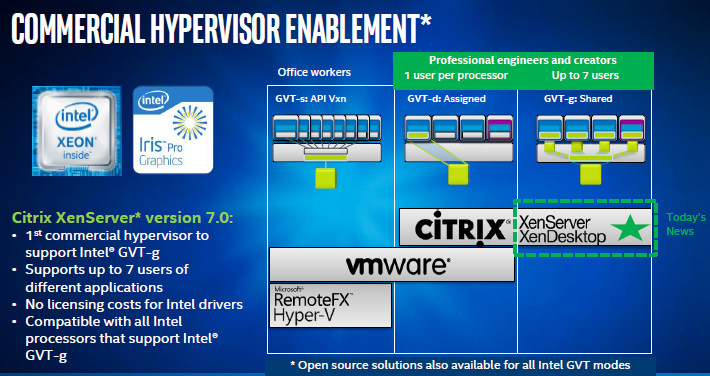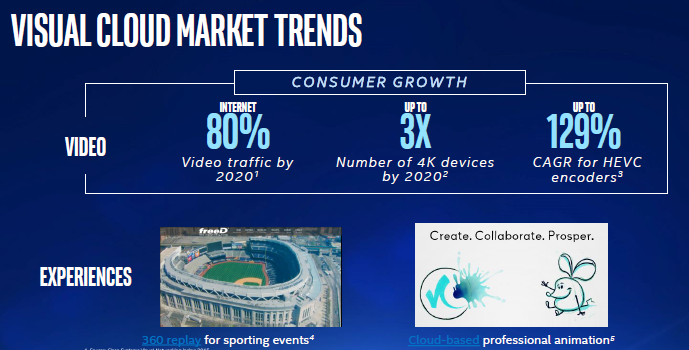Today Intel has formally launched a new Intel Xeon E3-1500 V5 series of processors. The Intel Xeon E3-1500 V5 series of processors was formerly known as “Skylake-H”. Intel briefed us on this new line of processors some time ago. In short, these processors are Skylake desktop cores with Intel Iris Pro graphics. One way to characterize them is similar traditional x86 compute to the Xeon E3-1200 V5 line, however with higher-end graphics.
Intel Xeon E3-1500 V5 SKUs
There are five SKUs in the Intel Xeon E3-1500 V5 line-up.

As one can see, Intel stopped using core and thread counts to differentiate its lineup, instead relying upon clock speed, TDP and onboard graphics version. The Intel Xeon E3-1558L V5 has the lowest CPU clocks at 1.9GHz and is the only chip with the Iris Pro P555. The other four chips all feature the Iris Pro P580 with clock speeds ranging from 2.0GHz to 3.5GHz and TDP from 35W to 65W.

Unlike the Intel Xeon E3-1200 V5 processors with onboard GPUs, Iris Pro graphics onboard means that these chips do have eDRAM onboard.
We did not have a sample to test on hand at this point, however Intel did supply some figures for the market:

These are vendor supplied numbers so please do keep that in mind.
Target Markets
On the press pre-briefing, Intel focused on two markets: GPU accelerated virtual desktops and video transcoding.
Perhaps one of the most intriguing markets is the GPU accelerated virtual desktops. Intel and Citrix announced GVT-g support last week at Citrix Synergy.

Essentially, with Citrix XenServer 7.0 one can start to virtualize Intel GPUs for remote desktops and remote applications, effectively sharing GPUs among multiple simultaneous users. This is very similar to NVIDIA’s GRID technology and driver. The major differences here are that the GPUs on the Intel Xeon E3-1500 V5 line are integrated with the Intel CPU and the cost. NVIDIA’s GRID driver is a pricey addition to a VDI stack. Intel’s is providing the GVT-g support for free. Here are the quick notes on Intel GVT versions:
- GVT-s – office users where they can share application running on the processor
- GVT-d – direct GPU access for heavy GPU users
- GVT-g – virtualizes Intel Graphics driver into 2-7 instances so multiple VMs/ users can get GPU acceleration
In the video transcoding space, Intel is responding to market dynamics that are seeking solutions to encode/ transcode video that is a growing part of web storage and bandwidth.

The message here was that Intel sees video being a key growth vector in IoT and has been creating solutions to help service providers handle video transcoding for some time.
Final Words
From what we have heard, we are seeing significantly more emphasis on video transcoding in the market. From what we heard, a card based on previous generation Intel parts, the Intel VCA series, saw strong adoption. We expect the next version of Intel VCA to be updated with the Intel Xeon E3-1500 V5 parts aimed at broadcasters. Intel also mentioned that for higher-end encoding, it suggests the use of Altera FPGAs which is one of the first briefings where we have heard Intel push the FPGA line. On the virtualization side, the GVT-g technology is a big deal, much as SR-IOV was for networking. We have started to get hardware like the HPE Moonshot chassis and Supermicro MicroBlade chassis that will support these chips and applications.




